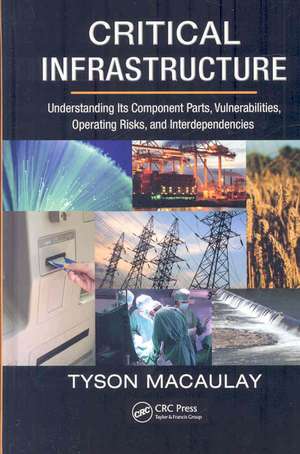Critical Infrastructure: Understanding Its Component Parts, Vulnerabilities, Operating Risks, and Interdependencies
Autor Tyson Macaulayen Limba Engleză Hardback – 27 aug 2008
Going beyond definitions, Critical Infrastructure: Understanding Its Component Parts, Vulnerabilities, Operating Risks, and Interdependencies looks at the iron triangle within CI: power, telecom, and finance. It introduces the concept of CI as an industrial and enterprise risk conductor, highlighting the reality that a CI failure can propagate a crisis with far-reaching repercussions.
Focuses on Canada and the US Equally for a Useful Cross-Border Security Analysis
With $2.5 trillion at stake in United States’ CI alone, supreme standards and metrics are mandatory for solid protection of such a sophisticated and complex area. This powerful volume is dedicated to moving CI security into the 21st century, illustrating the danger in basing critical CI policy decisions on the existing legacy frames of reference. It represents one of the first complete departures from policy, planning, and response strategies based on intuition and anecdotal evidence.
Preț: 1050.26 lei
Preț vechi: 1312.83 lei
-20% Nou
Puncte Express: 1575
Preț estimativ în valută:
200.100€ • 208.25$ • 167.74£
200.100€ • 208.25$ • 167.74£
Carte tipărită la comandă
Livrare economică 21 martie-04 aprilie
Preluare comenzi: 021 569.72.76
Specificații
ISBN-13: 9781420068351
ISBN-10: 1420068350
Pagini: 340
Ilustrații: 122 b/w images and 104 tables
Dimensiuni: 156 x 234 x 23 mm
Greutate: 0.59 kg
Ediția:1
Editura: Taylor & Francis
Colecția CRC Press
Locul publicării:Oxford, United Kingdom
ISBN-10: 1420068350
Pagini: 340
Ilustrații: 122 b/w images and 104 tables
Dimensiuni: 156 x 234 x 23 mm
Greutate: 0.59 kg
Ediția:1
Editura: Taylor & Francis
Colecția CRC Press
Locul publicării:Oxford, United Kingdom
Public țintă
Academic, Professional, and Professional Practice & DevelopmentCuprins
Critical Infrastructure: What, Who Cares, and Why. Econometrics and Critical Infrastructure Interdependency. Information and Data Dependency Analysis. Correlation, Dependency Latency, and Vulnerabilities of Critical Infrastructure. Critical Infrastructure Threat–Risk. Critical Infrastructure Interdependency Case Studies.
Recenzii
Going beyond definitions, this book looks at all the defined CI sectors and suggests previously overlooked, yet critical, industries for inclusion in revised definitions. Authored by a leading security specialist, this powerful volume includes more than 200 tables and 100 figures that illustrate key concepts, considers all CI sectors for a 360-degree view, and focuses on Canada and the US equally to provide a useful cross-border security analysis. Dedicated to moving CI security into the 21st century, this book illustrates the danger in basing critical CI policy decisions on the existing legacy frames of reference. It represents one of the first complete departures from policy, planning, and response strategies based on intuition and anecdotal evidence.
—MCEER, May 2010
Macaulay captures the crux of CI – its complex interdependencies – but does so in a clear, concise, and compelling way, providing the fundamentals for approaching CI in a manner familiar to security professionals: risk assessment. … The text is extremely well-written …
—J. Kelly Stewart, Certified Forensic Consultant, writing in Security Management, April 2010
—MCEER, May 2010
Macaulay captures the crux of CI – its complex interdependencies – but does so in a clear, concise, and compelling way, providing the fundamentals for approaching CI in a manner familiar to security professionals: risk assessment. … The text is extremely well-written …
—J. Kelly Stewart, Certified Forensic Consultant, writing in Security Management, April 2010
Descriere
Critical Infrastructure (CI) is a little understood topic, which seems to generate more fear than rational discussion. CIs are considered fundamental to the functioning of modern economies. Moving beyond definitions, this volume looks at the iron triangle within CI: power, telecom, and finance. It introduces the concept of CIs as industrial and enterprise risk conductors, highlighting the fact that a CI failure can propagate an impact throughout an enterprise. This text rethinks the concept of a CI according to contemporary factors, providing guidance for mitigating risk within the framework of national economies.



















